Automotive Innovation: Smart Headlamps Light the Way
Automobiles are getting smarter and smarter—various integrated camera and sensing systems can now help you back up safely, park, avoid a collision, stay in your lane, alert you to a vehicle in your blind spot, and supplement your vision at night, among other features. The Advanced Driver-Assistance Systems (ADAS) that have these capabilities typically use embedded-vision, RADAR, and/or LiDAR-based technology to continuously monitor the environment outside the vehicle.
Another automotive technology advancement is internet-enabled vehicles that allow various IoT integrations ranging from connecting to your smart phone, to navigating, to identifying preventive maintenance issues in your engine. Also under development are advanced “Connected Vehicle” systems as a joint effort of car/device makers and the U.S. Department of Transportation (DOT).
Among a range of potential applications, connected vehicle systems will enable your car to exchange information with other vehicles on the road. For example, you could receive an alert if another car is running a red light at the intersection you are about to drive across, or if a vehicle is coming quickly around a blind curve.
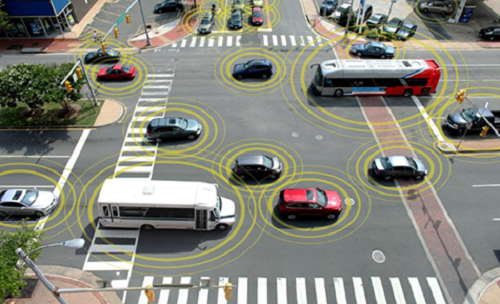
Visualization of the future of connected cars, buses, and trucks. The technology will enable vehicles to "talk" to each other with built-in or aftermarket devices that continuously share important safety and mobility information. (Image: U.S. Department of Transportation1)
Spotlight on Headlights
Headlights are also getting smarter. Headlights are a ”mission-critical” safety feature, especially for driving at night or in poor weather conditions. For this reason, they are subject to demanding performance requirements and must meet stringent automotive and highway safety standards.
The US and Canada follow the DOT’s federal standards for headlight visibility, durability, and reliability. In other geographies, standards created by The United Nations Economic Commission for Europe (ECE) have been adopted. The Society of Automotive Engineers (SAE) International standards also guide requirements for headlight performance around the globe. As new headlight technologies emerge, they are all subject to acceptance by one or more of these standards bodies.
One of the newer headlamp technologies that’s been approved for widespread use is “adaptive driving beam” (ADB) headlights. Essentially, ADB headlamps act as high-beams by default (improving visibility for the driver), but with an automatic dimming function that will reduce specific portions of the beam when an oncoming vehicle is detected by sensors (so as not to blind the other driver). Typical low beams are not optimal for helping a driver stop in time to avoid a collision if the vehicle is going faster than 35 mph;2 high beams can illuminate the road farther ahead, enabling a driver to react in time.
In late 2018, the U.S. National Highway Traffic Safety Administration (NHTSA) decided to allow ADB headlights in the US, which had already been approved for use in Europe.3 For example, Bosch offers an “intelligent headlight control” feature for its LED headlamps, using a video camera system to measure the ambient brightness and estimate the distance of vehicles in front of the car and oncoming traffic. Using this data, the system can implement a variety of light adjustments to beam brightness and angle.
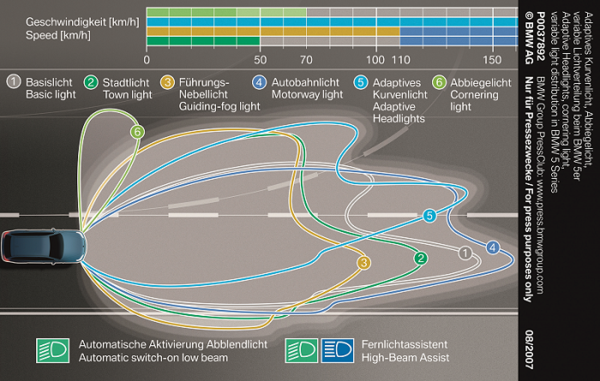
Illustration of BMW’s adaptive headlight system from its 5 Series vehicles. Audi, Mercedes, Toyota, and other car makers also offer this type of lighting. (Image © BWM)
ADB-equipped vehicles use electronic sensors to capture information about vehicle speed, steering, and elevation to adapt the headlights to a range of driving activity. Many adaptive headlight systems also include a self-leveling feature that adjusts the angle of the light beam up or down based on whether the car is tilted forward or back (e.g., while on a hill or going over a bump).4 Additionally, the light beams can be angled, for example, bending to the right as a driver turns the steering wheel to the right, focusing illumination around a curve.
ADB technology has been followed by additional recent advancements in headlight systems, some of which are available now and still others are on the horizon:
- Researchers on the Carnegie Mellon University Illumination and Imaging team have developed a programmable headlight. Using a spatial light modulator, beam splitter, camera, and processor, they’ve created a low-latency reactive visual system that can “sense, react, and adapt quickly to any environment while moving at highway speeds.”5 The programmable system can not only control high beams like ADB, but can improve visibility during snowstorms, enhance lane visibility, and provide early visual warning of obstacles. In snow conditions, the system streams light between snowflakes to reduce visual interference, as remarkable as that sounds.
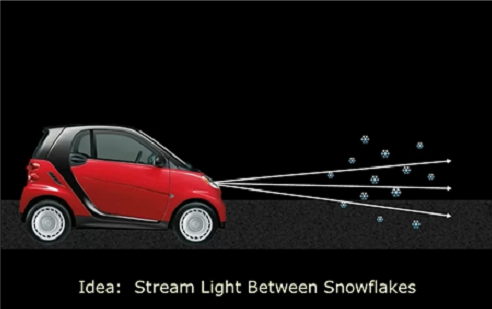
The programmable headlight prototype can stream light between snowflakes to improve visibility. To view a video of this and other features of Carnegie Mellon’s smart headlight design, visit: https://www.cs.cmu.edu/smartheadlight/.
- Taiwan-based Jasper Display has been developing microLEDs for the electronic display industry, but they’ve also applied the technology to headlamps. They’ve developed a system that enables images (such as directional or safety icons) to be projected onto the road in front of a vehicle. In some ways the concept is similar to augmented reality, but with information projected onto the road surface outside the vehicle, rather than onto the windshield or a head-up display unit inside. MicroLEDs offer advantages for headlight use due to their high efficiency, long lifespan, and greater environmental tolerance—for instance, tthey can operate at temperatures from -150°F up to +250°F.6
- Meanwhile, Osram offers headlights that use laser diodes. These headlights include three blue lasers that fire beams onto a set of mirrors, which then focus the energy into a lens filled with yellow phosphorus. This lens in turn emits an intense white light. Unlike “raw” laser beams, the reflected light of these beams is safe for the human eye. Laser headlamp models have so far been used in the BMW i8, BMW 7 Series, and Audi R8 LMX. Lasers The benefit of lasers is that they have almost four times the brightness of LEDs and provide a bright white light with a longer range than traditional yellow LED low beams.
Quality Testing for Headlights
As a vital component of safe vehicle operation, headlamps are subjected to rigorous testing by automobile OEMs and component manufacturers. Meeting stringent regulatory standards also demands consistent, documented test and measurement results. Radiant’s ProMetric® imaging photometers and colorimeters provide precise analysis of a headlight’s performance, whether it uses LED, halogen, microLED, laser or other illumination technology.
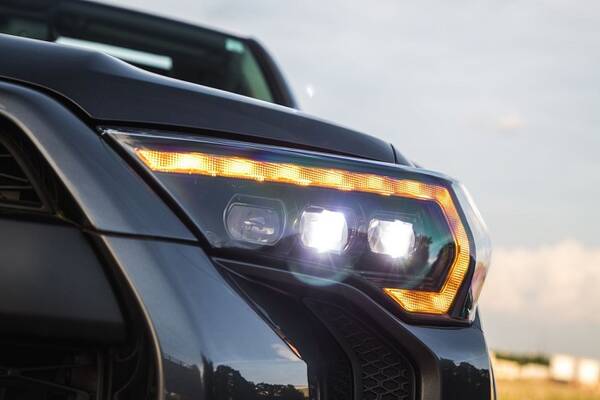
A modern automotive headlamp package includes multiple components, such as those shown in this Toyota 4Runner XB LED headlight assembly: LED projector high beam, dual LED projector low beam, white LED parking light (low intensity), and an LED strip that is used to provide selectable (solid or sequential) amber turn signal and white daytime running light. (Image Source)
Headlamp Evaluation Solution
Today's smart headlamps require multiple measurements to ensure proper illumination at all settings. An effective and efficient method for evaluating headlamp performance is to project the light source onto a prepared flat surface (a wall or a diffuser), where the imaging colorimeter captures the illumination distribution in a single measurement. A manufacturer can then analyze the assembly on a number of user-defined criteria using Radiant’s PM-HL™ Headlamp Evaluation Module, designed specifically for headlamp evaluation. PM-HL functions include:
- Light source illuminance distribution measurement
- Evaluation of ECE and SAE Regulation test points
- Evaluation of custom test points
- Evaluation of beam pattern cut-off gradients
- Conversion to luminous intensity distribution
- Conversion to roadway illumination distribution
- Data analysis functions, including bitmaps, isoplots, and cross-sections
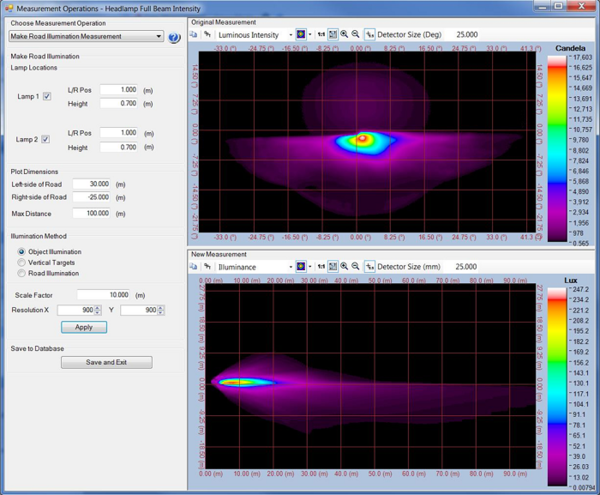
PM-HL software interface showing measurement images of headlamp beam patterns. In the top image, the luminous intensity distribution of a headlamp beam pattern is measured on a Lambertian surface. In the bottom image, the “Make Road Illumination Measurement” operation is used to extrapolate the same headlamp beam projected onto a roadway.
A complete headlight test solution combines PM-HL Software and a ProMetric imaging system to measure all visual qualities of the light source. To measure illumination distribution within a small test area, like a lab, a PM-HL solution relies on the near-field distribution of a source. The headlamp is mounted on a fixture or goniometer while an imaging colorimeter, driven by automated measurement control and analysis software, measures the direct luminance or lit-appearance at all view angles. Far-field luminous intensity distribution can then be calculated from near-field data using the PM-HL Software. The illuminance distribution can be calculated for any arbitrary distance and overlaid with Road Illumination plots in software to show the distribution shape and size.
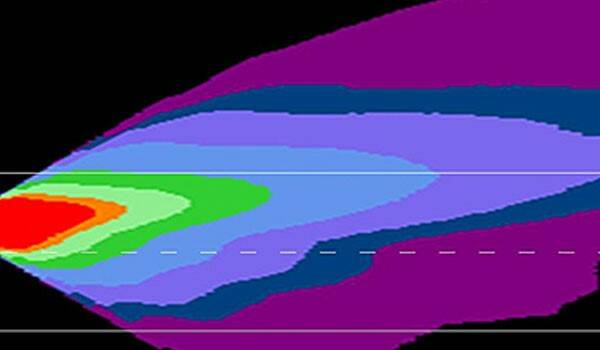
A 2D isometric plot can be used to display the Road Illumination plot, overlaid here with a representation of the road in PM-HL Software.
LED Strips and Light Pipes
Direct measurement of LED strips and pipes in headlamp assemblies can also be addressed with a ProMetric Imaging Colorimeter and ProMetric or TrueTest™ Software. Within a single image captured by a ProMetric camera system, manufacturers can measure uniformity of luminance and color along a cross-section or path (accommodating all shapes) and detect failed LEDs in a cluster or array. Radiant software registers all individual LEDs in an array from a single image and uses dynamic ROI to determine individual LED locations to report the performance of each including luminance, chromaticity, and other visual qualities.
Learn more about the headlamp measurement systems and software capabilities of Radiant's PM-HL Headlamp Evaluation Module.
CITATIONS
- “What Are Connected Vehicles and Why Do We Need Them”, U.S. Department of Transportation, Intelligent Transportation Systems Joint Program Office, Office of the Assistant Secretary for Research and Technology. https://www.its.dot.gov/cv_basics/cv_basics_what.htm (retrieved March 10, 2020)
- Taub, E., “Smart Headlights Inch Closer to American Roads”, The New York Times, November 21, 2018.
- León, B., “US to allow brighter, self-dimming headlights on new cars”, The Car Connection, October 12, 2018.
- Grabianowski, E., “How Adaptive Headlights Work”, howstuffworks.com (retrieved March 13, 2020).
- “Programmable Automotive Headlights”, Carnegie Mellon Illumination and Imaging (retrieved March 12, 2020).
- Hale, K., “MicroLED: Small Size, Big Impact” on Texas Tech University Discoveries (retrieved March 13, 2020).
Join Mailing List
Stay up to date on our latest products, blog content, and events.
Join our Mailing List
